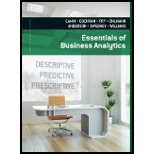
Consider the following time series data:

Using the naïve method (most recent value) as the forecast for the next week, compute the following measures of forecast accuracy:
- a.
Mean absolute error - b. Mean squared error
- c. Mean absolute percentage error
- d. What is the forecast for week 7?
(a)
Find the value of mean absolute error.
Answer to Problem 1P
The mean absolute error is 4.4.
Explanation of Solution
| Week | Time Series Value | Forecast | Forecast Error | Absolute Value of Forecast Error |
| 1 | 18 | |||
| 2 | 13 | 18 | −5 | 5 |
| 3 | 16 | 13 | 3 | 3 |
| 4 | 11 | 16 | −5 | 5 |
| 5 | 17 | 11 | 6 | 6 |
| 6 | 14 | 17 | −3 | 3 |
| Total | 22 |
Thus, the mean absolute error is 4.4.
(b)
Obtain the mean squared error.
Answer to Problem 1P
The mean squared error is 20.8.
Explanation of Solution
The mean squared error is obtained as given below:
| Absolute Value of Forecast Error | Squared Forecast Error |
| 5 | 25 |
| 3 | 9 |
| 5 | 25 |
| 6 | 36 |
| 3 | 9 |
| 22 | 104 |
Thus, the mean squared error is 20.8.
(c)
Find the mean absolute percentage error.
Answer to Problem 1P
The mean absolute percentage error is 31.88.
Explanation of Solution
The mean absolute percentage error is obtained is given below:
| Week | Time Series Value | Forecast | Forecast Error | Percentage Error | Absolute percentage Error |
| 1 | 18 | ||||
| 2 | 13 | 18 | −5 | −38.46 | 38.46 |
| 3 | 16 | 13 | 3 | 18.75 | 18.75 |
| 4 | 11 | 16 | −5 | −45.45 | 45.45 |
| 5 | 17 | 11 | 6 | 35.29 | 35.29 |
| 6 | 14 | 17 | −3 | −21.43 | 21.43 |
| Total | −51.30 | 159.38 |
Thus, the mean absolute percentage error is 31.88.
(d)
Obtain the forecast for week 7.
Answer to Problem 1P
The forecast for week 7 is 14.
Explanation of Solution
The forecast for week 7 is obtained as given below:
Thus, the forecast for week 7 is 14.
Want to see more full solutions like this?
Chapter 5 Solutions
Essentials Of Business Analytics
- A marketing agency wants to determine whether different advertising platforms generate significantly different levels of customer engagement. The agency measures the average number of daily clicks on ads for three platforms: Social Media, Search Engines, and Email Campaigns. The agency collects data on daily clicks for each platform over a 10-day period and wants to test whether there is a statistically significant difference in the mean number of daily clicks among these platforms. Conduct ANOVA test. You can provide your answer by inserting a text box and the answer must include: also please provide a step by on getting the answers in excel Null hypothesis, Alternative hypothesis, Show answer (output table/summary table), and Conclusion based on the P value.arrow_forwardA company found that the daily sales revenue of its flagship product follows a normal distribution with a mean of $4500 and a standard deviation of $450. The company defines a "high-sales day" that is, any day with sales exceeding $4800. please provide a step by step on how to get the answers Q: What percentage of days can the company expect to have "high-sales days" or sales greater than $4800? Q: What is the sales revenue threshold for the bottom 10% of days? (please note that 10% refers to the probability/area under bell curve towards the lower tail of bell curve) Provide answers in the yellow cellsarrow_forwardBusiness Discussarrow_forward
- The following data represent total ventilation measured in liters of air per minute per square meter of body area for two independent (and randomly chosen) samples. Analyze these data using the appropriate non-parametric hypothesis testarrow_forwardeach column represents before & after measurements on the same individual. Analyze with the appropriate non-parametric hypothesis test for a paired design.arrow_forwardShould you be confident in applying your regression equation to estimate the heart rate of a python at 35°C? Why or why not?arrow_forward
 Glencoe Algebra 1, Student Edition, 9780079039897...AlgebraISBN:9780079039897Author:CarterPublisher:McGraw Hill
Glencoe Algebra 1, Student Edition, 9780079039897...AlgebraISBN:9780079039897Author:CarterPublisher:McGraw Hill College Algebra (MindTap Course List)AlgebraISBN:9781305652231Author:R. David Gustafson, Jeff HughesPublisher:Cengage Learning
College Algebra (MindTap Course List)AlgebraISBN:9781305652231Author:R. David Gustafson, Jeff HughesPublisher:Cengage Learning Holt Mcdougal Larson Pre-algebra: Student Edition...AlgebraISBN:9780547587776Author:HOLT MCDOUGALPublisher:HOLT MCDOUGAL
Holt Mcdougal Larson Pre-algebra: Student Edition...AlgebraISBN:9780547587776Author:HOLT MCDOUGALPublisher:HOLT MCDOUGAL Big Ideas Math A Bridge To Success Algebra 1: Stu...AlgebraISBN:9781680331141Author:HOUGHTON MIFFLIN HARCOURTPublisher:Houghton Mifflin Harcourt
Big Ideas Math A Bridge To Success Algebra 1: Stu...AlgebraISBN:9781680331141Author:HOUGHTON MIFFLIN HARCOURTPublisher:Houghton Mifflin Harcourt Functions and Change: A Modeling Approach to Coll...AlgebraISBN:9781337111348Author:Bruce Crauder, Benny Evans, Alan NoellPublisher:Cengage Learning
Functions and Change: A Modeling Approach to Coll...AlgebraISBN:9781337111348Author:Bruce Crauder, Benny Evans, Alan NoellPublisher:Cengage Learning Trigonometry (MindTap Course List)TrigonometryISBN:9781305652224Author:Charles P. McKeague, Mark D. TurnerPublisher:Cengage Learning
Trigonometry (MindTap Course List)TrigonometryISBN:9781305652224Author:Charles P. McKeague, Mark D. TurnerPublisher:Cengage Learning





